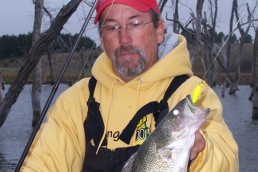Plastic Baits for Walleyes
SHARE THIS POST
Bob Jensen makes a case for plastics to catch spring walleyes.
Some friends and I gathered recently, and as so often happens, the talk turned to fishing. One friend indicated that he was seriously thinking about trying plastic baits for walleyes this fishing season. Another friend said it was “about time.” Some anglers have been using plastic baits instead of live baits for walleyes for a good number of years. Others haven’t made the jump yet. There are situations when plastic baits will produce as many walleyes as live bait—sometimes more—and will be much easier to use.
I remember my first venture into the world of plastic for walleyes. It was the late ‘70s and I was living in Brainerd, Minnesota. The Mississippi River flows through Brainerd, and I spent too much time on the banks of the river casting for walleyes. On this day, I was throwing a jig that had a 3-inch white Mister Twister attached. I was catching walleyes regularly. An angler down the bank noticed my success and walked over and asked what I was using. I showed him. His reaction was hard to understand. Upon seeing what I was using, he commented, “Those things don’t work” and returned to his fishing spot. I went back to catching walleyes with those “things that don’t work.” Since that time, I’ve incorporated plastic into my walleye fishing with very good results.
In spring, many anglers wade the shallow areas of rivers and lakes in search of pre-spawn walleyes. A jig/minnow combination historically is the most used presentation. In recent years, though, a jig with a plastic tail has become very popular. An angler doesn’t need to drag a minnow bucket along when using plastic, and with the many shapes and colors available in plastic baits, you can present the fish with a unique and more appealing presentation.
Another time when a jig/plastic combo is productive is when summer walleyes are along the deep weed line, which occurs more often than anglers might think. A jig tipped with a leech or minnow will catch them, but that combination will be pecked at and ruined by panfish. Also, when casting to the weed line, jigs will often hang on the vegetation. When the jig is snapped off the weed, the live bait is frequently snapped off the jig.
Are you enjoying this post?
You can be among the first to get the latest info on where to go, what to use and how to use it!
A jig tipped with plastic is much more durable than a jig tipped with live bait. Walleye tournament angler Drake Herd often has a Slick Shad or Rage Swimmer attached to his jig when a jig/plastic combo is appropriate. They stand up to the panfish pecks and vegetation, and the walleyes like to eat them. He prefers bright plastic in stained water and plastic that resembles a real minnow in clear water.
In some waters, trolling with spinners rigged with nightcrawlers is a popular and productive presentation for walleyes during summer and fall. But just like with panfish along the weedline, spinners with nightcrawlers attract unwanted attention. Panfish and sheepshead will nip at the ‘crawler until it is of no value as a walleye attractant. Plastic ‘crawlers will usually work just as well and are much, much more durable. You won’t need to re-bait plastic ‘crawlers as often as live ‘crawlers. Many of the successful anglers who use plastic ‘crawlers add some scent to make them even more attractive to walleyes. They also experiment with color and have found that, in addition to natural-appearing plastic ‘crawlers, orange and chartreuse are good color options.
There are certainly times when live bait will out-produce plastic. But color, shape and durability often make plastic more appropriate and productive. You don’t need to keep plastic ‘crawlers in a cooler to keep them alive, and the floor of your boat will stay cleaner. No more spilled worm dirt or nightcrawler entrails to clean up! For me, that is enough reason to use plastic baits more often.
Looking for some new fishing techniques to try this season? You’ll find plenty of suggestions in every issue of MidWest Outdoors. Subscribe on our website.
MWO
SHARE THIS POST
You may also like...
Nothing found.
Did you enjoy this post?
You can be among the first to get the latest info on where to go, what to use and how to use it!
Bob Jensen
To see the latest episodes of “Fishing the Midwest” television, new fishing-related tips and articles from the past, visit fishingthemidwest.com. Follow them on Facebook @fishingthemidwest for fishing information and entertainment.
